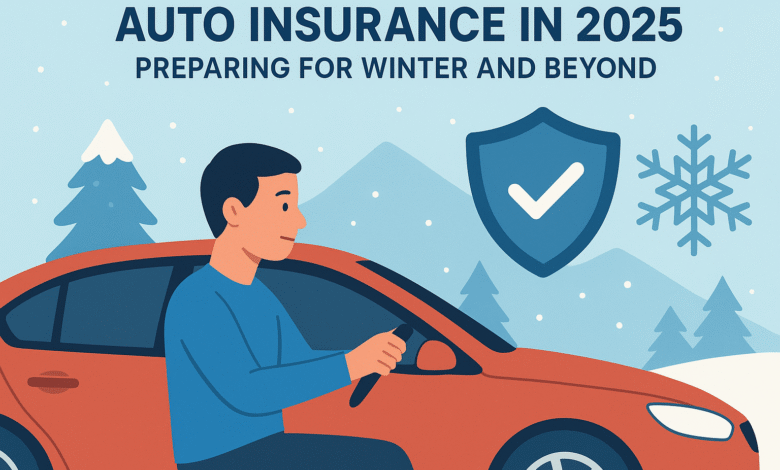
As autumn turns to winter in 2025, drivers face new challenges on the road. Snow, ice, and shorter days increase accident risks, making auto insurance a critical consideration. This guide explores the essentials of auto insurance, coverage options for winter conditions, cost factors, and tips for choosing the right policy as of late September 2025. Whether you’re a daily commuter or planning a holiday road trip, this article provides the information needed to protect yourself and your vehicle.
Table of Contents
- What Is Auto Insurance?
- Key Coverage Types for Winter Driving
- Factors Affecting Auto Insurance Costs in 2025
- Preparing Your Vehicle and Policy for Winter
- How to Choose the Right Auto Insurance
- Common Mistakes to Avoid
- Final Thoughts
What Is Auto Insurance?
Auto insurance protects drivers from financial losses due to accidents, theft, or damage. It is legally required in most regions, with minimum coverage varying by state or country. In 2025, policies have evolved to address modern risks, such as autonomous vehicle malfunctions or climate-related hazards like flooding from melting snow.
A standard policy typically includes:
- Liability coverage: Pays for damage or injuries you cause to others.
- Collision coverage: Covers repairs to your vehicle after an accident, regardless of fault.
- Comprehensive coverage: Protects against non-collision events like theft, vandalism, or weather damage.
- Uninsured/underinsured motorist: Compensates for damages if hit by a driver with insufficient insurance.
Optional add-ons, such as roadside assistance or rental car reimbursement, enhance protection. Understanding these components helps drivers select coverage that matches their needs.
Key Coverage Types for Winter Driving
Winter conditions in 2025, with predictions of harsher storms, make specific coverages essential. Consider these options:
Liability Coverage
This is the legal minimum in most places (e.g., 25/50/25 in the U.S., meaning $25,000 per person/$50,000 per accident for injury, $25,000 for property damage). In snowy regions, higher limits (e.g., 100/300/100) protect against costly multi-vehicle pileups on icy roads.
Collision Coverage
Covers repairs or replacement if you hit another vehicle or object, like a guardrail in a skid. With repair costs rising—up 10% from 2024 due to supply chain issues—this is vital for winter accidents.
Comprehensive Coverage
Protects against weather-related damage, such as hail, fallen branches, or flooding from snowmelt. In 2025, insurers report a 15% increase in comprehensive claims during winter months, highlighting its importance.
Uninsured/Underinsured Motorist Coverage
With 1 in 8 drivers uninsured in the U.S., this covers injuries or damage if hit by such a motorist. Winter’s low visibility heightens this risk, making it a smart addition.
Additional Winter Add-Ons
- Roadside Assistance: Covers towing or fuel delivery if stranded in snow. Essential for rural areas.
- Personal Injury Protection (PIP): Pays medical bills regardless of fault, useful if injured in a slip on ice.
- Gap Insurance: Covers the difference if your car is totaled and you owe more than its value, common with new vehicles.
Factors Affecting Auto Insurance Costs in 2025
The average auto insurance premium in 2025 is $1,800–$2,200 annually, up 8% from 2024 due to inflation and weather claims. Key influences include:
- Location: Drivers in snowy states (e.g., Minnesota, Vermont) pay 20–30% more due to higher claim rates.
- Driving Record: Accidents or tickets raise premiums. A clean record can earn a 10–15% discount.
- Vehicle Type: SUVs and trucks, popular for winter, cost more to insure than sedans due to repair expenses.
- Mileage: Higher annual mileage (e.g., over 12,000 miles) increases rates, as winter driving adds risk.
- Credit Score: Poor scores can raise costs by 20% in states where credit is a factor.
- Coverage Level: Adding comprehensive or high liability limits increases premiums but reduces out-of-pocket costs.
Discounts for safe driving, anti-theft devices, or bundling with home insurance can lower costs. Check with providers for tailored savings.
Preparing Your Vehicle and Policy for Winter
Late September 2025 is the ideal time to prepare. Follow these steps:
- Winterize Your Vehicle: Install winter tires, check antifreeze, and replace wiper blades. A well-maintained car reduces claim likelihood.
- Review Your Policy: Ensure coverage matches your vehicle’s value and winter risks. Update if you’ve added a trailer or changed usage.
- Increase Limits if Needed: Raise liability or comprehensive coverage for peace of mind during storms.
- Add Seasonal Add-Ons: Consider roadside assistance or gap insurance before winter hits.
- Document Your Car: Take photos of its condition to support claims if damaged by weather.
In 2025, telematics devices (e.g., usage-based insurance apps) offer discounts for safe winter driving. Enroll early to track habits.
How to Choose the Right Auto Insurance
Selecting a policy requires balancing cost and protection. Use this approach:
- Assess Your Needs: Consider commute length, vehicle value, and winter exposure. A rural driver needs more than an urban one.
- Compare Quotes: Get estimates from at least three insurers via sites like The Zebra or Progressive. Look at coverage details, not just price.
- Check Exclusions: Verify what’s not covered (e.g., off-road use, intentional damage) to avoid surprises.
- Review Insurer Ratings: Use AM Best or Consumer Reports to assess financial strength and customer service.
- Ask About Discounts: Inquire about multi-policy or good-driver savings.
In 2025, online quote tools allow real-time adjustments. Test different deductibles (e.g., $500 vs. $1,000) to find your sweet spot.
Common Mistakes to Avoid
Drivers often err in ways that leave them vulnerable:
- Skipping Comprehensive: Assuming weather damage won’t happen risks uncovered repairs.
- Underinsuring: Low limits (e.g., 25/50/25) won’t cover major winter accidents. Aim for 100/300/100.
- Ignoring Deductibles: A low deductible saves on premiums but increases out-of-pocket costs. Match it to your budget.
- Not Updating Policies: Failing to adjust for a new car or address change raises gaps.
- Relying Solely on Minimums: Legal minimums often fall short in severe winters.
Final Thoughts
Auto insurance in 2025 is essential for navigating winter’s challenges and beyond. With proper coverage and preparation, you can drive confidently through snow and ice. Review your policy now, especially with holiday travel nearing, and adjust as needed. For general advice on auto coverage, email safepolicynow4@gmail.com.




